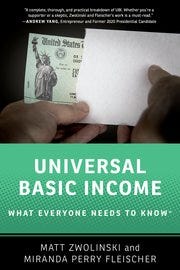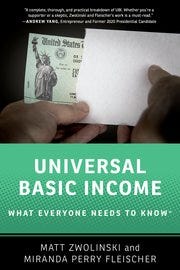My new book with Miranda Fleischer: Universal Basic Income: What Everyone Needs to Know, launches one week from today - October 4th! You can order it now on Amazon or if, like me, you do a lot of your “reading” via audiobook, grab it on Audible.
In case you missed it, I posted the Table of Contents for the book here, along with several excerpts from the book covering the main arguments for and against the UBI. Today, I want to share an excerpt that covers a question that a lot of you have asked: what’s the difference between a UBI and Milton Friedman’s idea of a Negative Income Tax?
Enjoy! And if you like these excerpts and want to read more, be sure to pre-order your copy today!
CHAPTER 29
HOW DOES A BASIC INCOME COMPARE TO A NEGATIVE INCOME TAX?
We’ve now seen the similarities and differences between a UBI and a variety of existing benefit programs. How does a UBI compare to other common proposals for new redistributive programs? For example, you might have heard about the concept of a Negative Income Tax (NIT), which Milton Friedman popularized as a means of replacing existing welfare programs. An NIT sounds very different from a UBI because, well, it sounds like a tax, not a benefit! But as we’ll see, in most circumstances, the two are mathematically equivalent. Friedman’s coauthor (and spouse) Rose Friedman described the idea as follows:
The basic idea of a negative income tax is simple . . . Under the current positive income tax you are permitted to receive a certain amount of income without paying any tax . . . This amount is composed of a number of elements— personal exemptions . . . standard deduction . . . [etc.] To simplify the discussion, let us use the simpler British term of “personal allowances” to refer to this basic amount.
If your income exceeds your allowances, you pay a tax on the excess at rates that are graduated according to the size of the excess. Suppose your income is less than the allowances? Under the current system, those unused allowances in general are of no value. You simply pay no tax . . .
With a negative income tax, you would receive from the government some fraction of the unused allowances . . . When your income was above allowances, you would pay tax, the amount depending on the tax rates charged on various amounts of income. When your income was below allowances, you would receive a subsidy, the amount depending on the subsidy rates attributed to various amounts of unused allowances.
To illustrate, imagine a negative income tax with a personal allowance of $30,000 and a tax rate of 20% on all income above $30,000. Individuals with incomes below $30,000 will receive a payment that equals 20% of the difference between $30,000 and their pre- tax income. Thus:
• Amy, who earns $0, receives a net transfer from the government equal to 20% of her unused $30,000 allowance, or $6,000 (20% × (0 – $30,000) = −$6,000; i.e., a subsidy of $6,000);
• Bruno, who earns $30,000, owes nothing and is owed nothing; and
• Chloe, who earns $60,000, pays a tax of 20% on all her income above $30,000, or $6,000 (20% × ($60,000 − $30,000) = $6,000).
This is mathematically equivalent to a UBI coupled with a tax on non- UBI income. Imagine a UBI of $6,000 paid to all regardless of income coupled with a 20% tax on all other income, with no exemption amount. Thus:
• Amy, who earns $0, receives a UBI payment of $6,000 but pays no tax, resulting in a net transfer from the government to Amy of $6,000;
• Bruno, who earns $30,000, receives a UBI payment of $6,000 but pays tax of $6,000 (20% of $30,000), resulting in a net transfer of zero;
• Chloe, who earns $60,000, receives a UBI payment of $6,000 but pays tax of $12,000 (20% of $60,000), resulting in a net transfer from Chloe to the government of $6,000.
And both are mathematically equivalent to a UBI that explicitly phases out with income. Consider a UBI of $6,000 that phases out at a 20% rate starting with one’s first dollar of non- UBI income that is coupled with a 20% tax on non- UBI income over $30,000. Such a UBI fully phases out once income hits $30,000 (20% × $30,000 = $6,000). Thus:
Amy, who earns $0, receives a UBI of $6,000 and pays no income tax, for a net transfer from the government of $6,000;
• Bruno, who earns $30,000, receives no UBI (his UBI fully phases out) and pays no income tax, for a net transfer of zero; and
• Chloe, who earns $60,000, receives no UBI (again, on account of the phaseout) and pays income tax of $6,000 (20% × ($60,000 – $30,000)), for a net transfer to the government of $6,000.
The first example involves an NIT; the second involves a UBI that doesn’t explicitly phase out coupled with a tax on all non- UBI income; and the third involves a UBI that explicitly phases out with income and is coupled with a tax on non- UBI income over an exemption amount. But all result in the same net transfers between Amy, Bruno, Chloe, and the government.
Three points about these examples. First, although they use a flat rate of 20%, the equivalence holds in tax systems that use graduated rate structures. Second, they envision individuals as the taxable unit, while the tax systems of the United States and a few European countries (such as France and Germany) generally use families. Nothing mandates, however, that an income tax system use the family instead of an individual as the taxable unit, and in fact, many OECD countries use the individual.
Third, the examples assume that an income tax will fund a UBI. The sole circumstance in which an NIT and UBI are not economically equivalent is if a UBI is funded solely from sources other than taxes on income (or a base strongly correlated with income). Imagine a UBI funded solely by revenue from auctioning off the broadband spectrum. In such a case, Amy, Bruno, and Chloe each receive $6,000, regardless of their income, since the revenue from firms that purchase broadband spectrum is not correlated with their individual incomes. But as we discuss in chapter 12, almost every serious UBI proposal of any significant scope would require some, if not all, of its funding from increased taxes on income or a base like consumption that strongly correlates to income.
Assuming that a UBI will be at least partially funded by income taxes, we can see that the key difference between a UBI and an NIT is one of optics. A UBI appears to be just that— universal— while an NIT is explicitly tied to one’s income. UBI proponents argue that universal framing is key to minimizing the stigma associated with poverty, and that a drawback of an NIT is that it— like traditional welfare programs— explicitly targets the poor. And it may be the case that such framing increases support among some members of the public, given the popularity of seemingly universal programs like Social Security and Medicare. But it may also reduce support in other quarters. NIT proponents argue that the superficial universality of a UBI undermines its political viability, due to the “Why are we paying a UBI to Jeff Bezos?” rejoinder.





Yes, there’s strong arguments to prefer a UBI to NIT. But one thing that speaks in favour of NTI, is that a UBI would demand higher tax rates to collect the funds that are then distributed. Even those that are compensated for their taxes by the UBI and have the same net income as before, will face a higher marginal tax rate, with all the disincentives that causes.